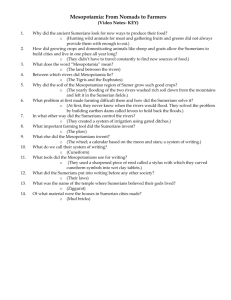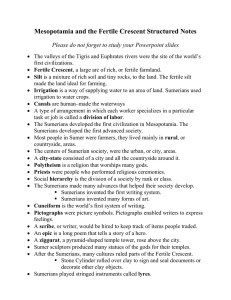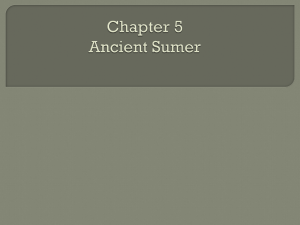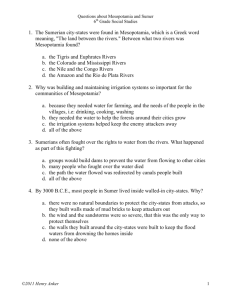Fertile Crescent
advertisement
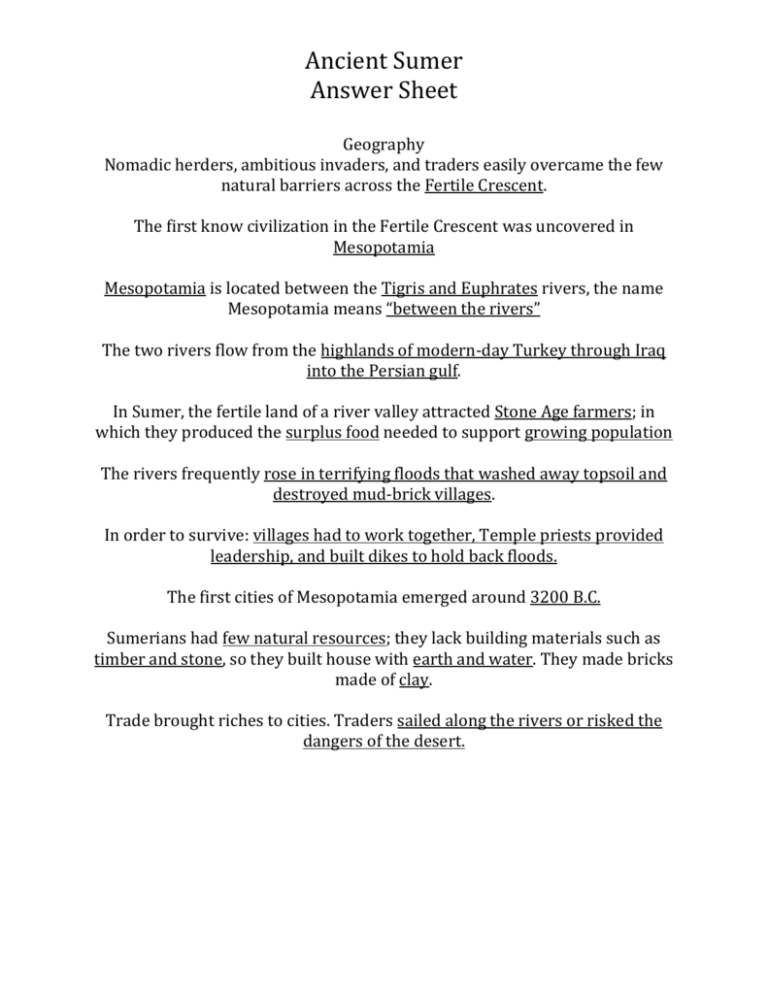
Ancient Sumer Answer Sheet Geography Nomadic herders, ambitious invaders, and traders easily overcame the few natural barriers across the Fertile Crescent. The first know civilization in the Fertile Crescent was uncovered in Mesopotamia Mesopotamia is located between the Tigris and Euphrates rivers, the name Mesopotamia means “between the rivers” The two rivers flow from the highlands of modern-day Turkey through Iraq into the Persian gulf. In Sumer, the fertile land of a river valley attracted Stone Age farmers; in which they produced the surplus food needed to support growing population The rivers frequently rose in terrifying floods that washed away topsoil and destroyed mud-brick villages. In order to survive: villages had to work together, Temple priests provided leadership, and built dikes to hold back floods. The first cities of Mesopotamia emerged around 3200 B.C. Sumerians had few natural resources; they lack building materials such as timber and stone, so they built house with earth and water. They made bricks made of clay. Trade brought riches to cities. Traders sailed along the rivers or risked the dangers of the desert. Sumerian Civilization Rival Sumerian city-states often battled for control of land and water. Each city-state, the ruler was responsible for: 1. Maintaining the city walls. 2. Led armies and enforced laws. 3. As government grew more complex, employed scribes to carry out functions such as collecting taxes and keeping records. Each city-state had a distinct social hierarchy (system of ranks). The Highest class consisted of: ruling family, leading officials, and high priests. The middle class consisted of: merchants and artisans The lower class consisted of: peasant farmers and slaves. Some peasant farmers had their own land, but most worked land belonging to the king. Sumerians also owned slaves, Most slaves had been captured in war; some had sold themselves into slavery to pay their debts. Like most ancient peoples, Sumerians were polytheistic, worshipping many gods. Contrast to Ancient Egypt, Sumerian believed they control every aspect of life. Sumerian gods and goddesses behaved like ordinary people. Sumerians believed their highest duty was to keep these divine beings happy and thereby ensure safety to their city-state. Sumerians built ziggurats a pyramid-temple that soared toward the heavens. To win the favor gods, the people prayed and offered sacrifices of animals, grain, and wine. Like the Egyptians, Sumerians believed in an after life. However, they saw the underworld as a grim place from which there was no release. Advances in Learning By 3200 B.C., the Sumerians invented what may be the earliest form of writing; this writing is called cuneiform. Cuneiform grew out of a system of pictographs that priests used to record goods brought to temple storehouses. Sumerians scribes had to go through years of difficult schooling to acquire their skills. Discipline was strict. Untidy copying or talking in class could be punished by “caning.” Gifted students went to gain a range of knowledge in religion, medicine, mathematics and literature. Over the centuries, Sumerians scholars made advances in mathematics. To measure and solve problems, they developed algebra and geometry. They based their number system on six, dividing the hour into 60 minutes and the circle in 360 degrees, as we still do today.


